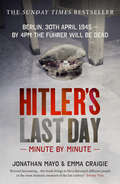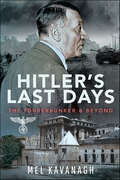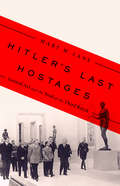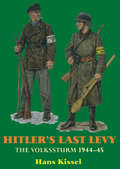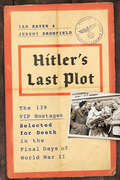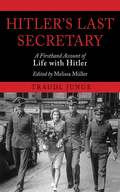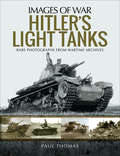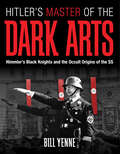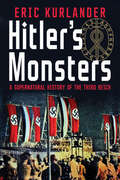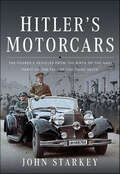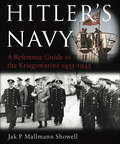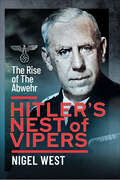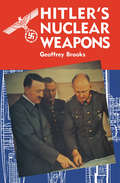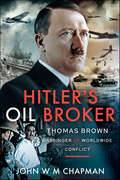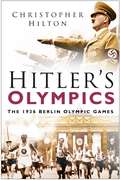- Table View
- List View
Hitler's Last Day: The Hidden Story Of An Ss Family In Wartime Germany (Minute By Minute Ser.)
by Jonathan Mayo Emma CraigieOn 30th April 1945 Germany is in chaos...Russian troops have reached Berlin. All over the country, people are on the move - concentration camp survivors, Allied PoWs, escaping Nazis - and the civilian population is fast running out of food. The man who orchestrated this nightmare is in his bunker beneath the capital, saying his farewells.This is the gripping story of Hitler's final hours, as seen through the eyes of those who were with him in the bunker; those fighting in the streets of Germany; and those pacing the corridors of power in Washington, London and Moscow.30th April 1945 was a day that millions had dreamed of, and millions had died for.
Hitler's Last Days: The Führerbunker & Beyond
by Mel KavanaghStudies Hitler's final days in the Fuhrerbunker looking at the Nazi leader's state of mind during the war and the effect if had on his physical state. Berlin, April 1945. After almost six years of war, the end is nigh for the Nazi’s. The Russians are closing in on the German capital and Hitler is holed up in the Fuhrerbunker in the city. There was an eclectic mix of individuals residing in the bunker with Hitler at this time including senior Nazi officers, Hitler’s personal protection squad, soldiers, civilians, children and even a female test pilot but how did they fair at the end? Not all died or were captured. Hitler’s Last Days studies Hitler's final days in the Fuhrerbunker looking at the Nazi leaders' state of mind during the war and the effect if had on his physical state, despite only being 56 at the time of his death it was said by many that he looked somewhat older. But how did Hitler really die? Or did he escape as some evidence has previously suggested? A wealth of diverse research material has been used to create an account that comes from a different angle on a popular WWII story.
Hitler's Last Hostages: Looted Art and the Soul of the Third Reich
by Mary M. LaneAdolf Hitler's obsession with art not only fueled his vision of a purified Nazi state--it was the core of his fascist ideology. Its aftermath lives on to this day.Nazism ascended by brute force and by cultural tyranny. Weimar Germany was a society in turmoil, and Hitler's rise was achieved not only by harnessing the military but also by restricting artistic expression. Hitler, an artist himself, promised the dejected citizens of postwar Germany a purified Reich, purged of "degenerate" influences.When Hitler came to power in 1933, he removed so-called "degenerate" art from German society and promoted artists whom he considered the embodiment of the "Aryan ideal." Artists who had produced challenging and provocative work fled the country. Curators and art dealers organized their stock. Thousands of great artworks disappeared--and only a fraction of them were rediscovered after World War II.In 2013, the German government confiscated roughly 1,300 works by Henri Matisse, George Grosz, Claude Monet, and other masters from the apartment of Cornelius Gurlitt, the reclusive son of one of Hitler's primary art dealers. For two years, the government kept the discovery a secret. In Hitler's Last Hostages, Mary M. Lane reveals the fate of those works and tells the definitive story of art in the Third Reich and Germany's ongoing struggle to right the wrongs of the past.
Hitler's Last Levy: The Volkssturm 1944-45
by Hans KisselA companion volume to our very successful In a Raging Inferno—Combat Units of the Hitler Youth, Hans Kissel's study offers a highly-detailed account of the German Volkssturm, or Home Guard. Formed from men unfit for military service, the young, and the old, this ad-hoc formation saw extensive combat during the desperate defense of the Reich, 1944-45. The author describes the Volkssturms training, leadership, organization, armament and equipment, in addition to its active service on both the Eastern and Western fronts. The text is supported by an extensive selection of appendices, including translations of documents and many fascinating eyewitness combat reports. This edition also includes over 150 previously unpublished b/w photos, and 4 pages of specially-commissioned color uniform plates by Stephen Andrew.
Hitler's Last Plot: The 139 VIP Hostages Selected for Death in the Final Days of World War II
by Jeremy Dronfield Ian SayerRevealed for the first time: how the SS rounded up the Nazis' most prominent prisoners to serve as human shields for Hitler in the last days of World War IIIn April 1945, as Germany faced defeat, Hitler planned to round up the Third Reich's most valuable prisoners and send them to his "Alpine Fortress," where he and the SS would keep the hostages as they made a last stand against the Allies. The prisoners included European presidents, prime ministers, generals, British secret agents, and German anti-Nazi clerics, celebrities, and officers who had aided the July 1944 bomb plot against Hitler--and the prisoners' families. Orders were given to the SS: if the German military situation deteriorated, the prisoners were to be executed--all 139 of them.So began a tense, deadly drama. As some prisoners plotted escape, others prepared for the inevitable, and their SS guards grew increasingly volatile, drunk, and trigger-happy as defeat loomed. As a dramatic confrontation between the SS and the Wehrmacht threatened the hostages caught in the middle, the US Army launched a frantic rescue bid to save the hostages before the axe fell.Drawing on previously unpublished and overlooked sources, Hitler's Last Plot is the first full account of this astounding and shocking story, from the original round-up order to the prisoners' terrifying ordeal and ultimate rescue. Told in a thrilling, page-turning narrative, this is one of World War II's most fascinating episodes.
Hitler's Last Secretary: A Firsthand Account of Life with Hitler
by Melissa Muller Traudl JungeIn 1942 Germany, Traudl Junge was a young woman with dreams of becoming a ballerina when she was offered the chance of a lifetime. At the age of twenty-two she became private secretary to Adolf Hitler and served him for two and a half years, right up to the bitter end. Junge observed the intimate workings of Hitler’s administration, she typed correspondence and speeches, including Hitler’s public and private last will and testament; she ate her meals and spent evenings with him; and she was close enough to hear the bomb that was intended to assassinate Hitler in the Wolf’s Lair, close enough to smell the bitter almond odor of Eva Braun’s cyanide pill. In her intimate, detailed memoir, Junge invites readers to experience day-to-day life with the most horrible dictator of the twentieth century.
Hitler's Last Witness: The Memoirs of Hitler's Bodyguard
by Rochus MischThis memoir of Hitler&’s personal bodyguard presents &“convincing first-person testimony of the dictator&’s final desperate months, days and hours&” (Huffington Post). After being seriously wounded in the 1939 Polish campaign, Rochus Misch was invited to join Hitler&’s SS-bodyguard. There he served until the war&’s end as Hitler&’s bodyguard, courier, orderly, and, finally, as Chief of Communications. On the Berghoff terrace, he watched Eva Braun organize parties, observed Heinrich Himmler and Albert Speer, and monitored telephone conversations from Berlin to the East Prussian Headquarters on July 20, 1944—after the attempt on Hitler&’s life. As the Allied forces closed in, Misch was drawn into the Führerbunker with the last of the faithful. He remained in charge of the bunker switchboard as his duty required, even after Hitler committed suicide. Misch knew Hitler the private man. His memoirs offer an intimate view of life in close attendance to Hitler and of the endless hours deep inside the bunker. They also provide new insights into military events—such as Hitler&’s initial feeling that the 6th Army should pull out of Stalingrad. Shortly before he died, Misch wrote a new introduction for this English-language edition.
Hitler's Light Panzers at War: Rare Photographs From Wartime Archives (Images of War)
by Paul ThomasHitler's Light Panzers at War is a highly illustrated record of the German light tank from its beginnings in the 1930s to the key battles it fought in Poland, France, North Africa, Russia and North Western Europe. The book analyses the development of the light Panzer, which ranged from the Panzer I, II and the Czech build Panzer 35 & 38t. It describes how the Germans carefully utilized the development of these light machines for war, and depicts how these tanks were adapted and up-gunned to face the ever-increasing enemy threat.Using 250 rare and unpublished photographs together with detailed captions and accompanying text, Hitler's Light Panzers At War provides a unique insight into the many variants that saw action on the battlefield. It provides a vivid account of light Panzer operational deployment from the early Blitzkrieg campaigns to the final demise of the Nazi war machine.
Hitler's Light Tanks (Images of War)
by Paul ThomasThis fully illustrated WWII history examines the varieties of German light tanks and their usage throughout the conflict with rare wartime photographs. At the outbreak of the Second World War, Hitler&’s Wehrmacht led the way in armored warfare as blitzkriegs overwhelmed Poland and North West Europe. The contribution of light tanks such as Panzers I, II and 35(t) was critical. As the war spread to the Balkans, north Africa and the invasion of Russia, German engineers modified existing light tanks and developed new models. These included tank destroyers such as the Marder III Panzerjäger, SdKfz 138/1 and 139. There were anti-aircraft variants, including the Flakpanzer 38(t), and reconnaissance tanks such as the SdKfz 140/1 and the Aufklarungerspanzer 38(t). This superbly illustrated book gives a comprehensive overview of the multitude of German light tanks that came into service. With the text and captions providing technical data, the images show this formidable array of fighting vehicles in action across the theatres of war.
Hitler's Light Tanks (Images of War)
by Paul ThomasThis fully illustrated WWII history examines the varieties of German light tanks and their usage throughout the conflict with rare wartime photographs. At the outbreak of the Second World War, Hitler&’s Wehrmacht led the way in armored warfare as blitzkriegs overwhelmed Poland and North West Europe. The contribution of light tanks such as Panzers I, II and 35(t) was critical. As the war spread to the Balkans, north Africa and the invasion of Russia, German engineers modified existing light tanks and developed new models. These included tank destroyers such as the Marder III Panzerjäger, SdKfz 138/1 and 139. There were anti-aircraft variants, including the Flakpanzer 38(t), and reconnaissance tanks such as the SdKfz 140/1 and the Aufklarungerspanzer 38(t). This superbly illustrated book gives a comprehensive overview of the multitude of German light tanks that came into service. With the text and captions providing technical data, the images show this formidable array of fighting vehicles in action across the theatres of war.
Hitler's Lost State: The Fall of Prussia and the Wilhelm Gustloff Tragedy
by Tim Heath Michela CocolinThis WWII history chronicles the rise and fall of Nazi Prussia as well as the ill-fated exodus of its civilian refugees in 1945.Seen as an agricultural utopia within Hitler’s Germany, Prussia is thought to have gone untouched during the Second World War. Yet the violence of the National Socialist regime was widespread throughout the German state. As the Red Army advanced on its borders in 1945, nearly ten thousand civilians evacuated the region aboard the MV Wilhelm Gustloff—only to perish when the ship was sunk by a Soviet submarine. It was the worst loss of life in maritime history, six times greater than that of the RMS Titanic.Combining existing material and new findings, this book tells the story of Prussia’s rise and fall as a military power. It chronicles the attempts made by brave civilians and military personnel to overturn the Nazi regime, as well as the desperate evacuation of refugees in one of the greatest exoduses ever seen, told by those who were there.
Hitler's Master of the Dark Arts: Himmler's Black Knights and the Occult Origins of the SS
by Bill YenneA history of Nazi Germany’s SS and its leader examining the groups mystical cult aspects and Himmler’s rise through the ranks of power.Hitler’s Nazi Party, at its evil roots, embraced a bizarre interpretation of ancient European paganism, blending it with fragments of other traditions from sources as diverse as tenth-century Saxon warlords, nineteenth-century spiritualism, and early-twentieth-century fringe archeology. Even the swastika, the hated symbol of Nazism, had its roots in ancient symbolism, its first recorded appearance carved into a mammoth tusk twelve thousand years before Hitler came to power.At the heart of the evil was Hitler’s “witch doctor,” Heinrich Himmler, and his stranger-than-fiction cult, the deadly SS. The mundanely named Schutzstaffel, literally “protective squadron,” was the very essence of Nazism, and their threatening double lightning bolt was one of the most dreaded symbols of the Third Reich. With good reason: what the SS was truly protecting was the ideology of Aryan superiority.Hitler’s Master of the Dark Arts is the first history of the SS and its leader to focus on the mystical cult aspects of the organization. It follows Himmler’s transformation of the SS from a few hundred members in 1929 to over fifty thousand black-uniformed Aryans by the mid-1930s. Concurrent with its expansion and its eventual independence from the brown shirts of the SA, Himmler infused the Black Knights with a mishmash of occult beliefs and lunatic-fringe theories that would have been completely laughable—except that they were also used to justify the Final Solution.
Hitler's Millennial Reich: Apocalyptic Belief and the Search for Salvation
by David RedlesAfter World War I, German citizens sought not merely relief from the political, economic, social, and cultural upheaval which wracked Weimar Germany, but also mental salvation. With promises of order, prosperity, and community, Adolph Hitler fulfilled a profoundly spiritual need on behalf of those who converted to Nazism, and thus became not only Führer, but Messiah contends David Redles, who believes that millenarian sentiment was central to the rise of Nazism.As opposed to many works which depersonalize Nazism by focusing on institutional factors, Redles offers a fresh view of the impact and potential for millenarian movements. The writings of both major and minor Nazi party figures, in which there echoes a striking religiosity and salvational faith, reveal how receptive Germans were to the notion of a millennial Reich such as that offered by Hitler. Redles illustrates how Hitler's apocalyptic prophecies of a coming "final battle" with the so-called Jewish Bolsheviks, one that was conceived to be a “war of annihilation,” was transformed into an equally eschatological “Final Solution”
Hitler's Monsters: A Supernatural History of the Third Reich
by Eric Kurlander&“A dense and scholarly book about . . . the relationship between the Nazi party and the occult . . . reveals stranger-than-fiction truths on every page.&”—Daily Telegraph The Nazi fascination with the occult is legendary, yet today it is often dismissed as Himmler&’s personal obsession or wildly overstated for its novelty. Preposterous though it was, however, supernatural thinking was inextricable from the Nazi project. The regime enlisted astrology and the paranormal, paganism, Indo-Aryan mythology, witchcraft, miracle weapons, and the lost kingdom of Atlantis in reimagining German politics and society and recasting German science and religion. In this eye-opening history, Eric Kurlander reveals how the Third Reich&’s relationship to the supernatural was far from straightforward. Even as popular occultism and superstition were intermittently rooted out, suppressed, and outlawed, the Nazis drew upon a wide variety of occult practices and esoteric sciences to gain power, shape propaganda and policy, and pursue their dreams of racial utopia and empire. &“[Kurlander] shows how swiftly irrational ideas can take hold, even in an age before social media.&”—The Washington Post &“Deeply researched, convincingly authenticated, this extraordinary study of the magical and supernatural at the highest levels of Nazi Germany will astonish.&”—The Spectator &“A trustworthy [book] on an extraordinary subject.&”—The Times &“A fascinating look at a little-understood aspect of fascism.&”—Kirkus Reviews &“Kurlander provides a careful, clear-headed, and exhaustive examination of a subject so lurid that it has probably scared away some of the serious research it merits.&”—National Review
Hitler's Motorcars: The Führer's Vehicles From the Birth of the Nazi Party to the Fall of the Third Reich
by John StarkeyAs well as providing photographs of Hitler’s cars and the men who became his chauffeur, John Starkey lists the technical specifications of those cars, and describes many of the journeys undertaken by the German leader over the course of two dramatic decades. Many are the photographs of Hitler standing proudly in the passenger seat of a midnight blue Mercedes, arm outstretched in his famous salute to the adoring German crowds. Hitler loved cars and loved to be seen in and next to the special automobiles he purchased or was presented with through friends and Nazi Party funds. His first car was a 1920 green Selve 8/30, purchased in 1922, which was soon disposed of in favor of a Daimler-built Mercedes 15/70/100 – and from that moment on every car in which Hitler was chauffeured around the Third Reich and occupied countries would be a Mercedes. Indeed, even while in Landsberg prison following his failed putsch in 1923, he was writing to a Mercedes-Benz car salesman in Munich about his next car, concerning the merits of the Benz 11/40 versus the larger 16/50. It was a grey 11/40 in which Hitler was driven away from Landsberg on his release in 1924. It was in his next car – a super-charged Mercedes-Benz 15/70/100 – that Hitler was involved in an accident with a large truck in March 1930. The truck was completely wrecked while the large Mercedes suffered only minor damage. This prompted Hitler to remark: ‘It was then I decided to use only a Mercedes for the rest of my life.’ From 1930 onwards, Hitler was driven around in a Mercedes-Benz 770, also known as the Grosser Mercedes. Only 205 of these huge, luxury cars were manufactured with many of those being used by top-ranking Nazis. Such was Hitler’s interest in cars, he arranged state sponsorship for Mercedes and Porsche (Auto Union) to participate in Grand Prix racing (today’s F1). So strong was the resulting financial support that German teams swept all before them between 1935 and 1939. Security was always a great concern of Hitler and his entourage and his 770 was protected with bullet-proof windows and steel armor-plate built into all metal work. Wartime brought increased security fears, resulting in another Mercedes entering the German leader’s car collection. This was the heavily armored, six-wheel G4, the first off-road Mercedes, in which Hitler could safely parade through the streets of conquered lands. As well as providing photographs of Hitler’s cars and the men who became his chauffeur, John Starkey lists the technical specifications of those cars, and describes many of the journeys undertaken by the German leader over the course of two dramatic decades.
Hitler's Mountain Troops, 1939–1945: The Gebirgsjager (Images of War)
by Ian BaxterA pictorial history of the Nazi special forces group, their training, and the action they saw during World War II. Hitler&’s mountain troops or Gebirgsjager were a group of elite soldiers ready for battle, whatever the conditions. These mountain men were trained to ski, climb and endure long marches, survive appalling conditions and were given a role as crack shock troops. Yet many of the campaigns in which the Gebirgsjager fought were on level ground where they had little opportunity to demonstrate their unique skills. Instead, they were invariably employed as assault infantry in conventional battle, a role in which every individual trooper excelled, but not one for which they had been trained. They fought in virtually all theaters of World War II, notably on the Eastern Front, where operations took them into the Caucasus. The Gebirgsjager were proud to wear the Edelweiss, the famous badge that set them apart and distinguished them as Hitler&’s mountain men. This superb book shows the Gebirgsjager in training and action from Poland, Norway, and France, through Yugoslavia, the Eastern Front, and in the closing stages of the War.
Hitler's Munich Man: The Fall of Admiral Sir Barry Domvile
by Martin ConnollyA &“fascinating&” account of the British director of Naval Intelligence who was interned during the Second World War as a Nazi sympathizer (The Armourer). Between the First and Second World Wars, there was a growth of fascism in Britain and anxiety about revolution was in the air. Concerns of a possible Fascist attempt to overthrow the established order were high, not to mention the rise of Hitler and the threat of invasion. With secret clubs and clandestine meetings now a threat, the security services decided to infiltrate their ranks. Sir Barry Domvile had served with honor during the First World War and had risen to director of Naval Intelligence. He became involved with Oswald Mosley and other far right leaders, also visiting prominent Nazis in Germany with whom he became enamored and formed &“The Link,&” a far right, pro-German organization. Concerns were raised and in 1940 he, along with his wife and son, were detained and imprisoned without trial under Regulation 18B of the Defence (General) Regulations 1939, under suspicion of being involved in a secret plot to bring in a Fascist Government. Hitler&’s Munich Man gives a detailed account of Domvile&’s background, detention, and hearings that were held behind closed doors and reveals the extent of his Fascism, pro-German attitudes and anti-Semitism. The first book to throw a spotlight on the saga, it examines his writings, both open and issued under a pseudonym, and considers the legitimacy of his detention. With photographs from the German archives, substantial coverage using the Secret Service files, Domvile&’s personal diaries, and other sources, the book will illuminate and inform the reader.
Hitler's Munich: The Capital of the Nazi Movement
by David Ian HallAn acclaimed historian of twentieth century Germany provides a vivid account of Hitler’s rise to power and its intimate connection to the Bavarian capital.The immediate aftermath of the Great War and the Versailles Treaty created a perfect storm of economic, social, political and cultural factors which facilitated the rapid rise of Adolf Hitler’s political career and the birth of the National Socialist German Worker’s Party. The breeding ground for this world-changing evolution was the city of Munich. In Hitler’s Munich, renowned historian David Ian Hall examines the origins and growth of Hitler’s National Socialism through the lens of this unique city. By connecting the sites where Hitler and his accomplices built the movement, Hall offers a clear and concrete understanding of the causes, background, motivation, and structures of the Party. Hitler’s Munich is a cultural and political portrait of the city, a biography of the Fuhrer, and a history of National Socialism. All three interacted in this expertly rendered exploration of their interconnections and significance.
Hitler's Navy: A Reference Guide to the Kreigsmarine 1935–1945
by Jak P. ShowellThe German Navy, both before the War and throughout the years of fighting, was heavily outnumbered by the navies of Great Britain and the United States; nonetheless, it proved to be serious thorn in the sides of its adversaries. The U-boat war in the North Atlantic threatened the very liberation of Europe, while the major warships posed a constant threat to the Allied shipping lanes. This important reference book is an indispensable guide to the ships, organisation, command and rank structure, and leaders of the Kriegsmarine, and helps explain why it was such a potent force. A detailed text, augmented by photos, maps and diagrams, studies the German Navy from the Treaty of Versailles to the collapse of the U-boat offensive and the demise of the Third Reich. After covering the background organisation and naval bases, the author gives detailed descriptions of all the classes of ship from the battleships to motor torpedo boats and minesweepers. The officers and sailors are covered along with their uniforms and awards and insignia. Biographies of notable personalities and a chronology of the main naval events are included, as well as appendices and a select bibliography.Based on the author's 1979 title The German Navy in World War Two, this is a classic work of reference for a new generation of readers.
Hitler's Nest of Vipers: The Rise Of The Abwehr
by Nigel West"...presents an excellent and concise narrative of the Abwehr's global intelligence network. West draws from hundreds of firsthand debriefing and summary reports including disclosed sources not previously available to scholars."—American Intelligence JournalModern historians have consistently condemned the Abwehr, Germany’s military intelligence service, and its SS equivalent, the Sicherheitsdienst (SD), as incompetent and even corrupt organizations. However, newly declassified MI5, CIA and US Counterintelligence Corps files shed a very different light on the structure, control and capabilities of the German intelligence machine in Europe, South America, the Mediterranean and the Middle East. It is usually stated that, under Admiral Canaris, the Abwehr neglected its main functions, its attention being focused more on trying to bring down Hitler. Yet Canaris greatly expanded the Abwehr from 150 personnel into a vast world-wide organisation which achieved many notable successes against the Allies. Equally, the SD’s tentacles spread across the Occupied territories as the German forces invaded country after country across Europe. In this in-depth study of the Abwehr’s rise to power, 1935 to 1943, its activities in Russia, the Baltic States, Ukraine, Japan, China, Manchuko and Mongolia are examined, as well as those in Thailand, French Indo-China, the Dutch East Indies, the Philippines, Iran, Turkey, Afghanistan, and the Arab nations. In this period, the Abwehr built a complex network of individual agents with transmitters operating from commercial, diplomatic and consular premises. Before, and in the early stages of the war, it later became apparent, the Abwehr was controlling a number of agents in Britain. Indeed, it was only after the war that the scale of the Abwehr’s activities became known, the organisation having of around 20,000 members. For the first time, the Abwehr’s development and the true extent of its operations have been laid bare, through official files and even of restored documents previously redacted. The long list of operations and activities of the Abwehr around the world includes the efforts of an agent in the USA who was arrested after a bizarre attempt to obtain a quantity of blank American passports by impersonating a senior State Department official, Edward Weston, an Under-Secretary of State. Also, former U.S. Marine, Kurt Jahnke, who was recruited to collect information about the American munitions production and send it on to Germany. These are just two of the numerous and absorbing accounts in this all-embracing study.
Hitler's Nuclear Weapons: From Doodlebug To Nuclear Warheads
by Geoffrey BrooksThe author of Hitler&’s Terror Weapons digs deep into the history of Nazi Germany&’s atomic research and development, separating fact from fiction. What were Hitler&’s fabled &“miracle weapons&” with which he promised to win the war for Germany at the last gasp? This book resolves the mystery and discusses the factors restraining Hitler from using them in Europe as Nazi Germany disintegrated. Here, too, is the conclusive evidence of Nazi-Japanese cooperation that convinced the Americans that no alternative existed but to strike preemptively against Japan as soon as the atomic bombs were ready. For the first time, hard facts are presented suggesting that it was not the United States but Hitler&’s Third Reich, which built the world&’s first nuclear reactor. And finally the controversy as to the role played in the Nazi atomic research by the Nobel Prize–winner professor Werner Heisenberg is settled once and for all.
Hitler's Official Programme RLE Responding to Fascism (Routledge Library Editions: Responding to Fascism)
by Gottfried FederIn 1927 Hitler asked Gottfried Feder to formulate the official Programme of the German National Socialist Party. This English translation of the fifth German edition was first published in 1934.
Hitler's Oil Broker: Thomas Brown, Harbinger of Worldwide Conflict
by John WM ChapmanThe biography of Thomas Brown,who provided the template for a successful search by the German navy for oil access. Thomas Brown is an unknown figure of Scottish origin who played a significant role in the onset and development of both world wars in the first half of the 20th century. In the First World War he contributed to the Anglo-German conflict in the Middle East particularly in his switch from UK to German nationality in 1914 by contributing directly to the expansion of German imperialism in the Persian Gulf and Ottoman Empire. His most important role was in providing logistical support to German and Turkish forces in support of the Turkish jihad in November 1914. Despite his arrest by MI5 as a suspected traitor in 1919, he returned to Germany as a business middleman aided by former political and military colleagues in the Weimar Republic. After promoting German interests in Iran, he was able as a company director to represent German steel manufacturers who bought into the Anglo-Italian British Oil Development Company (BOD) in Iraq. He helped to obtain an oil concession from independent in Iraq in 1932, and used his skills as a negotiator with British, German and Arab speakers to promote a large oil strike and major expansion of the company in 1935. It is here that the German-Italian axis comes to center-stage. Brown initially rejected Italian approaches to take over the company - exactly when Mussolini was trying to conquer Abyssinia - in favor of support for the UK investors, Lord Glenconner and Sir Percy Hunting. Brown was not fully aware of the maneuvering by the Hitler regime since autumn 1933 to promote alliances with Britain, Italy and Japan against the USSR and France, which ended in December 1935 with Hitler's preference for Italy. This was accelerated by Gestapo investigations into Italian involvement and Hitler's calculation that it would promote divisions among former allies and decrease German dependence on the world oil economy they dominated. Access to oil was key to military and political success. Brown belatedly understood that Britain was opposed to permitting Italy and Germany access to to key raw materials. Brown reported directly to Berlin even though he was mistakenly identified as a 'Scottish Jew' but he failed to recognize that Hitler's support for Italy enabled access to Italian oil while maintaining domestic sources of fuel for rearmament of the army and air force. Brown was terminally ill by 1936 but had provided the template for a successful search by the German navy for access to oil, independent of the Anglo-American dominance of the world oil industry.
Hitler's Olympics: The 1936 Berlin Olympic Games
by Christopher HiltonThe Berlin Olympic Games, more than 70 years on, remain the most controversial ever held. This book creates a vivid account of the disputes, the personalities, and the events which made these Games so memorable. Ironically, the choice of Germany as the host nation for the 1936 Olympics was intended to signal its return to the world community after defeat in World War I. In actuality, Hitler intended the Berlin Games to be an advertisement for Germany as he was creating it, and they became one of the largest propaganda exercises in history. Two Germans Jews competed in the Games while the most memorable achievement was that of black American Jesse Owens, who won four gold medals. Ultimately, however, Germany was the overall biggest medal winner. The popular success of Owens allowed the Nazis to claim that their policies had no racial element and charges of antisemitism that did arise were leveled at the Americans.
Hitler's Olympics: The Story of the 1936 Nazi Games (The\story Of The 1936 Nazi Games Ser.)
by Anton RipponThis &“startlingly good and vividly illuminating book&” sheds new light on the Fascist sports spectacle that transfixed the world (The Spectator). For two weeks in August 1936, Nazi Germany achieved an astonishing propaganda coup when it staged the Olympic Games in Berlin. Hiding their anti-Semitism and plans for territorial expansion, the Nazis exploited the Olympic ideal, dazzling visiting spectators and journalists alike with an image of a peaceful, tolerant Germany. In Hitler&’s Olympics, Anton Rippon tells the story of those remarkable Games, the first to overtly use the Olympic festival for political purposes. His account, which is illustrated with almost 200 rare photographs of the event, looks at how the rise of the Nazis affected German sportsmen and women in the early 1930s. And it reveals how the rest of the world allowed the Berlin Olympics to go ahead despite the knowledge that Nazi Germany was a police state.
